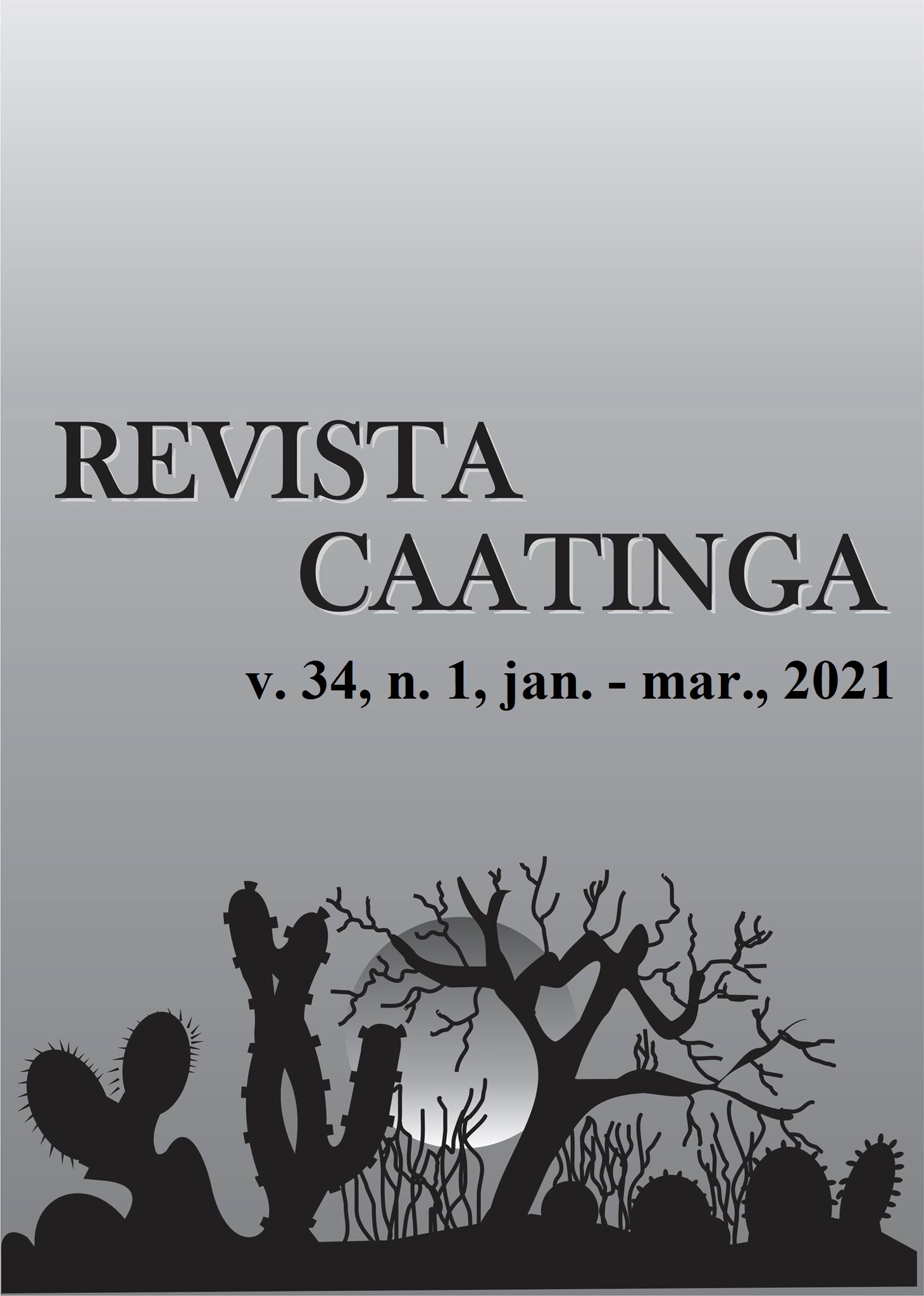IN VITRO SEED GERMINATION AND PLANT GROWTH OF “CABEÇA-DE-FRADE” (CACTACEAE)
DOI:
https://doi.org/10.1590/1983-21252021v34n101rcKeywords:
Melocactus. Culture medium. In vitro establishment. Chemical sterilization.Abstract
The genus Melocactus (“cabeça-de-frade”) comprises 32 species in Brazil, of which M. glaucescens and M. paucispinus are threatened with extinction. The present work evaluated the effects of different concentrations of Murashige & Skoog (MS, MS/2 and MS/4) culture medium and sucrose (15 g L-1 and 30 g L-1) on in vitro seed germination and plant growth of M. glaucescens and the efficiency of sterilization with sodium hypochlorite (NaOCl) on in vitro seed germination and plant growth of M. glaucescens when using seeds and M. glaucescens and M. paucispinus when using apical segment of cladode. In M. glaucescens, the final germination at the different MS and sucrose concentrations varied between 53.5 and 68.1% and the best results for in vitro growth were observed with the lowest mineral salt (MS/2 and MS/4) and sucrose (15 g L-1) concentrations, with lengths of the aerial portion of 9.70 and 10.76 mm, respectively. There was no difference in seed germination and plant growth in chemical and autoclave medium. It is concluded that the use of chemical sterilization with NaOCl at low concentrations of salts (MS/2 and MS/4) and sucrose (15 g L-1) are quite advantageous for producing ornamental plants germinated in vitro and/or apical segment of cladode of M. glaucescens and M. paucispinus, representing a reduction of costs for in vitro cultivation of this species.
Downloads
References
BEWLEY, J. D. et al. Seeds: physiology of development, germination and dormancy. 3 ed. NewYork: Springer, 2013. 392 p.
BRAVO FILHO, E. S. et al. Germination and acclimatization of Melocactus sergipensis Taylor & Meiado. Iheringia, Série Botânica, 74: e2019009, 2019.
BRONDANI, G. E. et al. Chemical sterilization of culture medium: a low cost alternative to in vitro establishment of plants. Scientia Florestalis, 41: 257-264, 2013.
CASTRO, J. P. et al. In vitro germination and disinfestation of sweet cactus (Nopalea cochenillifera (L.) Salm Dyck). Acta Scientiarum Agronomy, 33: 509-512, 2011.
CARDARELLI, M.; BORGOGNONE, D.; COLLA, G. In vitro propagation of Obregonia denegrii Frič. (Cactaceae). Propagation of Ornamental Plants, 10: 29-36, 2010.
CORTÉS-OLMOS C. et al. In vitro germination and growth protocols of the ornamental Lophophora williamsii (Lem.) Coult. as a tool for protecting endangered wild populations. Scientia Horticulturae, 237: 120-127, 2018.
FERREIRA, D. F. Sisvar: um sistema computacional de análise estatística. Ciência e Agrotecnologia, 35: 1039-1042, 2011.
HUANG, H. P. et al. Germplasm preservation in vitro of Polygonum multiflorum Thunb Pharmacognosy Magazine, 10: 179-184, 2014.
IUCN. IUCN Red List of Threatened Species. Version 2020.1. Available at: <https://www.iucnredlist.org/>. Accessed date: 22 apr. 2020.
LEMA-RUMIŃSKA, J.; KULUS, D. Induction of somatic embryogenesis in Astrophytum asterias (Zucc.) Lem. in the aspect of light conditions and auxin 2,4-d concentrations. Acta Scientiarum Polonorum - Hortorum Cultus, 11: 77-87, 2012.
LEMA-RUMIŃSKA, J.; KULUS, D., Micropropagation of cacti – a review. Haseltonia, 18: 46-63, 2014.
MACHADO, M. C. The genus Melocactus in eastern Brazil: part I - an introduction to Melocactus. British Cactus & Succulent Journal, 27: 1-16, 2009.
MEDEIROS, L. A. et al. In vitro propagation of Notocactus magnificus. Plant Cell Tissue and Organ Culture, 84: 165-169, 2006.
MURASHIGE, T.; SKOOG, F. A revised medium for rapid growth and bioassays with tobacco tissue cultures. Physiologia Plantarum, 15: 473-497, 1962.
OLIVEIRA, R. S. et al. Esterilização química e agentes geleificantes alternativos na propagação vegetativa in vitro do abacaxizeiro ‘Vitória’. Revista Brasileira de Fruticultura, 37: 819-826, 2015.
PÉREZ-MOLPHE-BALCH, E. et al. Tissue culture of ornamental cacti. Science in Agriculture, 72: 540–561, 2015.
PHILLIPS, G. C.; GARDA, M. Plant tissue culture media and practices: an overview. In Vitro Cell Developmental Biology - Plant, 55: 242-257, 2019.
RIBEIRO, J. M.; TEIXEIRA, S. L.; BASTOS, D. C. Cultivo in vitro de Sequoia sempervirens em meio de nutritivo esterilizado com hipoclorito de sódio. Ciência Florestal, 21: 77-82, 2011.
SANTOS, M. C. et al. Efeito da sacarose e do sorbitol na conservação in vitro de segmentos nodais de mangabeira. Revista Ciência Agronômica, 42: 735-741, 2011.
SANTOS, P. A. A. et al. Do diferente cultivation environments influence the germination and initial growth of three threatened Brazilian cacti species? South African Journal of Botany, 132: 363-370, 2020.
TAYLOR, N. P. et al. A new Melocactus from the Brazilian state of Sergipe. Bradleya, 32: 99–104, 2014.
TEIXEIRA, S. L. et al. Influence of NaClO on nutrient medium sterilization and on pineapple (Ananas comosus cv Smooth cayenne) behavior. Plant Cell Tissue and Organ Culture, 86: 375-378, 2006.
TEIXEIRA, S. L. et al. Utilização de hipoclorito de sódio na esterilização de meio de cultura para a multiplicação in vitro Eucalyptus pellita L. Ciência Florestal, 18: 185-191, 2008.
TORRES-SILVA, G. et al. In vitro shoot production, morphological alterations and genetic instability of Melocactus glaucescens (Cactaceae), an endangered species endemic to eastern Brazil. South African Journal of Botany, 115: 100–110, 2018.
ZAPPI, D.; TAYLOR, N. 2020. Cactaceae in Flora do Brasil 2020 em construção. Jardim Botânico do Rio de Janeiro. Available at: <http://reflora.jbrj.gov.br/reflora/floradobrasil/FB1558 Accessed date: 23 aug. 2020.
Downloads
Published
Issue
Section
License
Os Autores que publicam na Revista Caatinga concordam com os seguintes termos:
a) Os Autores mantêm os direitos autorais e concedem à revista o direito de primeira publicação, com o trabalho simultaneamente licenciado sob a Licença Creative Commons do tipo atribuição CC-BY, para todo o conteúdo do periódico, exceto onde estiver identificado, que permite o compartilhamento do trabalho com reconhecimento da autoria e publicação inicial nesta revista, sem fins comerciais.
b) Os Autores têm autorização para distribuição não-exclusiva da versão do trabalho publicada nesta revista (ex.: publicar em repositório institucional ou como capítulo de livro), com reconhecimento de autoria e publicação inicial nesta revista.
c) Os Autores têm permissão e são estimulados a publicar e distribuir seu trabalho online (ex.: em repositórios institucionais ou na sua página pessoal) a qualquer ponto antes ou durante o processo editorial, já que isso pode gerar alterações produtivas, bem como aumentar o impacto e a citação do trabalho publicado (Veja O Efeito do Acesso Livre).







